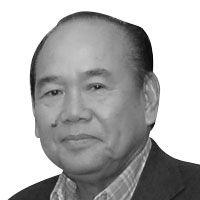Is SK the best way to train youth in governance?

First order of the day now that the 16th Congress of the Philippines has officially started is to congratulate Senator Franklin Drilon for being voted Senate President, his fourth time, in the Upper House; and Representative Sonny Belmonte, who continues his term as Speaker of the House.
Just as we have seen the culmination of elections that transpired last May with the presence of our newly elected lawmakers at the 4th State of the Nation Address of P-Noy, we will be seeing another election in October, this time for barangay officials and officers of the Sangguniang Kabataan (SK).
This is a synchronized election mandated by law to be held on the last Monday of October every three years starting 2007. Unlike the May elections, this will not be tallied by automatic counting machines.
Barangays, being the smallest division of government in the Philippines, deserve their leaders to be elected. I am not so sure though why the SK, which purportedly represents the youth sector, deserves to be given the support and resources of our bureaucracy.
Basis for SK
Let us review first the basis for having the SK. Youth representation in government received bigger attention in 1975 in response to the United Nations’ Convention on the Rights of the Child’s call to create an avenue wherein youth can engage and represent their sector.
The formal creation of the Kabataang Barangay (KB) by then President Ferdinand Marcos was supposedly the country’s response, although there were feelings of unease when his eldest daughter, Imee, was elected to head the youth organization.
Notwithstanding the political overtones of a dynasty rule, Imee proved she was capable of accomplishing many projects, including livelihood, sports, culture, and training programs to prepare the youth to take on government service.
While Marcos was in power, the existence of KB was unchallenged. But as soon as the regime was toppled by the People Power revolution in 1986, serious questions on its continued existence emerged. Youth consultations were held, and the KB was eventually abolished.
President Corazon Aquino, who succeeded Marcos, established the Presidential Council for Youth Affairs (PCYA) to coordinate with youth federations. But some lawmakers were not content with such a structure and lobbied for its formal inclusion in the political system.
Thus, every barangay was mandated to have a Katipunan ng Kabataan chapter composed of the youth aged 15 to 17 residing for at least six months in the locality. Each KK was supposed to elect its officers into the SK, with candidates to be not older than 18 at the time of candidacy.
Young and impressionable
The biggest problem that confronts the SK at the moment is its failure to involve and empower the youth in its locality, largely because of the age stipulation. At 15, even at 17 years of age, KK members are more involved, and rightly so, in school work.
Most of them have no more time outside their school obligations to get involved in the time-consuming shenanigans of their more senior political colleagues, not only at the barangay level, but sometimes even involving the mayor and governor.
This could also be a reason why there are allegations that SK officers are prey to barangay and municipal or city officers who wish to manipulate the power, perks and freebies that come with the SK involvement in the barangay youth sports and development.
Others, well, learn early from corrupt elders in the political arena. We’ve heard and read stories of how these youth leaders have learned how to manipulate government resources for their own personal gains, and have even defied accountability calls.
Reform alternative
The National Youth Commission, an organization that calls itself as the voice and advocate of the youth, is calling for the passage of the SK Reform and Empowerment bill as an alternative to pressure by other sectors to totally remove the KK and SK.
The NYC is, first and foremost, pushing for a change in the age of SKs from 15-17 to 18 to 24 so that there is supposedly a more mature pool of youth leaders. NYC is also asking for SKs to have fiscal autonomy while strengthening mechanisms for transparency and accountability.
In response to criticisms that the SK breeds political dynasties, the NYC is also pushing for anti-political dynasty clause. Many of the SK officials are usually related to barangay or municipal/city officers, and had won largely because of their relatives’ intervention.
No wonder then that these youth become mere shadows of the politicians who were instrumental in getting them elected.
Transparent discussions
For now, I’d like to start the ball rolling, i.e., expose to a public debate the reasons why the country should or should not continue with having the KK and SK. More importantly, let’s get studies done to determine just how effective the KK and SK is in fulfilling its objectives.
Offhand, I’d be very interested in knowing how many of the youths in barangays really participate in the KK. It would be nice to know also how many of the SK officials elected were relatives of incumbent local officials.
With the synchronized barangay-SK elections a done-deal already, let’s make use of the next months (and this new legislature) to get to the bottom of this issue. It would be a waste of government resources to spend on purported SK activities that are actually being run by current LGU officials for their own personal gains.
Visit www.CollegiateChampionsLeague.net
This is an invitation from the Philippine Collegiate Champions League (PCCL) to collegiate basketball fans interested in the ongoing competitions at various “mother leagues†nationwide. PCCL would welcome suggestions on how to make the website more informative as fans watch the progress of their favorite teams on their journey to the 2013 National Collegiate Championship.
Facebook and Twitter
We are actively using two social networking websites to reach out more often and even interact with and engage our readers, friends and colleagues in the various areas of interest that I tackle in my column. Please like us at www.facebook.com and follow us at www.twitter.com/ReyGamboa.
Should you wish to share any insights, write me at Link Edge, 25th Floor, 139 Corporate Center, Valero Street, Salcedo Village, 1227 Makati City. Or e-mail me at [email protected]. For a compilation of previous articles, visit www.BizlinksPhilippines.net.
- Latest
- Trending





























